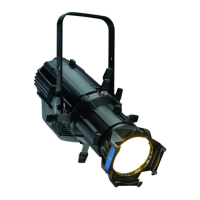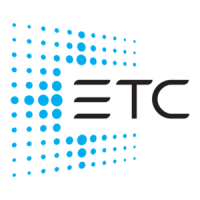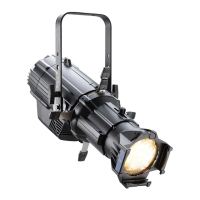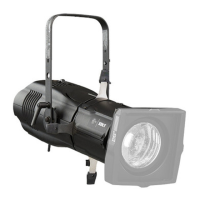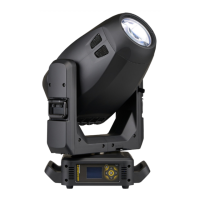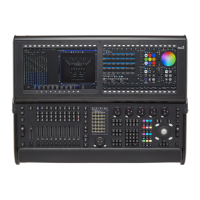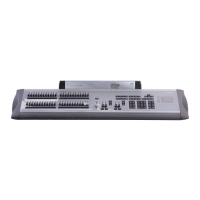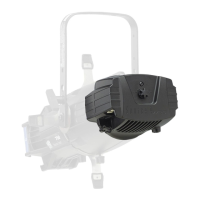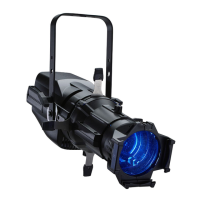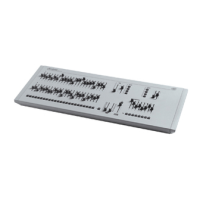Do you have a question about the ETC Lighting Control Console and is the answer not in the manual?
Introduction to basic operations and console setup.
Overview of the physical console components and layout.
Basic steps to power up the console and control lighting levels.
Introduction to recording lighting looks using submasters.
Diagram and description of the console's physical layout and ports.
Explanation of the console's keypad sections and functions.
Definitions of key console terms and components.
Instructions for safely cleaning the console exterior.
Configuration details for DMX output via ports or network.
Overview of system limits for channels, cues, palettes, and effects.
Description of the main display area and its components.
Explanation of softkey functionality and navigation.
Guide to navigating the browser interface for functions and settings.
Methods for opening, closing, and navigating displays.
Explanation of display formatting options like table, summary, and spreadsheet.
Steps to create a new show file via the browser.
How to load saved show files from various locations.
Loading specific components of a show file with advanced options.
Combining data from multiple show files into the current show.
Generating PDF output of show data and specific aspects.
Procedures for saving show data to the Show File Archive.
A fast method to save the current show data via a keyboard shortcut.
Saving show files to different locations or with new names.
Loading show files from ASCII or Lightwright formats.
Saving show data in standard formats like ASCII or CSV.
Procedures for removing show files and folders.
Tool for managing show files, folders, and USB drives.
Accessing the console's setup menu via hardkeys or browser.
Configuration settings related to the show file and its parameters.
Console-specific settings for facepanel, displays, and other hardware.
Fundamental concepts of patching channels to addresses.
Navigating and using the patch display interface.
Connecting standard dimmers and fixtures by channel or address.
Adding and configuring scroller devices in the patch.
Customizing scroller attributes and creating new scroller profiles.
Aligning scroller frames for accurate color or gobo positioning.
Configuring advanced fixtures with multiple parameters.
Navigating between different patch views and settings.
Managing RDM and network devices for patching and configuration.
Advanced setup for dimmer doubling with Sensor racks.
Data management within patch for channels and their associated records.
Rearranging channel assignments within the patch.
Removing channel assignments and resetting properties.
Removing channels entirely from the patch.
Resetting the patch to default or 1-to-1 configuration.
Updating fixture definitions from the console's library.
Creating and editing custom fixture types.
Controlling channel intensity levels using the console faders.
Methods for selecting channels using the keypad, groups, and level wheel.
Adjusting channel intensity values via faders, level wheel, or keypad.
Reselecting the previous channel or group selection.
Incrementally adjusting parameter values using keypad commands.
Temporarily dimming unselected channels to a specific level.
Fading channels to background levels or previous states over time.
Stepping through patched channels for inspection.
Directly controlling levels by DMX address without channel selection.
Stepping through patched DMX addresses for inspection.
Alternating intensity levels for selected channels or addresses.
Operating moving lights and accessing ML control displays.
Introduction to submaster functionality for storing and playback.
Procedures for storing current stage looks to submasters.
Controlling submaster timing using bump buttons and defined times.
Viewing and managing submaster properties and contents.
Foundational concepts of cue creation and playback.
Creating cues by recording current stage states.
Setting fade, dwell, and delay times for cues and their attributes.
Modifying cue behavior with flags like Block and Preheat.
Editing cue attributes and parameters in real-time.
Working with cues without affecting the live stage state.
Procedures for removing cues and their associated data.
Creating and storing channel groups for fast recall.
Methods for selecting groups using the keypad and group list.
Viewing and editing existing groups and their ordered channels.
Creating and storing intensity palettes with channel data.
Applying and recalling intensity palettes to channels.
Overview of cue playback controls and the master fader pair.
Display and management of the currently selected cue.
Executing cues outside the normal sequence using Go To Cue.
Using Go, Stop/Back, and Load buttons with playback faders.
Controlling cues via faders without the Go button.
Operating moving lights and accessing ML control displays.
Introduction to palette functionality and types.
Description of Intensity, Focus, Color, and Beam palettes.
Creating palettes by recording live parameter data.
Applying and recalling palettes to channels and groups.
Modifying palettes in live mode using Record or Update.
Modifying palettes without affecting the live stage state.
Overview of effect functionality for dynamic channel actions.
Viewing and managing recorded effects in the effect list.
Monitoring and editing currently running effects.
Creating sequential on/off effects like chases.
Defining progressive channel actions and transitions.
Handling multiple HTP intensity effects from different sources.
Offset-based effects using graphic editors for focus, color, and linear.
Using pre-created effects on channels or in cues.
Loading and running effects using submasters.
Adding delay timing to effects within cues or submasters.
Accessing general information about selected console items.
Details on connected network devices and system status.
Information specific to selected channels, including values, moves, and usage.
Details related to DMX addresses, including labels and patch info.
Information about selected cues, including timing, flags, and attributes.
Details on palette usage within cues.
Information regarding selected groups and their channels.
Details about applied curves and their usage.
Information on running effects, including their usage.
Copying data between channels or record targets.
Retrieving data from other locations like cues or submasters.
Relocating recorded data within the cue list or other targets.
Transforming referenced data into absolute values.
Reversing recent operations and restoring previous states.
Interface for viewing and managing parked channels and addresses.
Parking channels and parameters directly from the live display.
Proportional adjustment of parked intensity values in live mode.
Parking DMX addresses directly from the live display.
Parking channel parameters and addresses from the park display.
Introduction to cue segmentation into multiple parts.
Creating multipart cues by storing channels into parts live.
Creating multipart cues by breaking apart existing cues offline.
Understanding curve functionality for timing and output level relationships.
Steps to create new custom curves using the display editor.
Modifying existing curves using keypad and editor functions.
Using curves with cues, cue parts, or scroller fans.
Removing curves from the system or resetting to default.
Introduction to macros for automating programming and operating tasks.
Recording macros directly from live mode using the Learn function.
Interface for creating, editing, and managing macros.
Executing stored macros from the command line, cues, or other macros.
Removing macros from the list and confirming deletion.
Overview of user-created custom interactive displays.
Opening, navigating, and recalling magic sheet displays.
Methods for interacting with magic sheets using mouse, keyboard, or touchscreen.
Tools and techniques for building and customizing magic sheets.
Visual examples of magic sheets showcasing various objects and layouts.
Definition and role of channels in controlling lighting fixtures.
Numerical identifiers for actual dimmers, fixtures, or devices.
Data locations where information can be stored using the Record command.
A recorded lighting look stacked in a list for playback.
How channel levels change or persist between cues.
Values set via the command line that remain until a move instruction.
Introduction to the Element Configuration Utility (ECU) and its functions.
List of actions performable within the ECU for system configuration.
Initial interface of the ECU for selecting boot modes or settings.
The basic startup mode for the Element console.
Mode for configuring the desk as a remote video station.
Mode for offline editing without network activity.
Specifying the name for network identification.
Setting the console's current time manually or via SNTP.
Setting the console's current date manually or via SNTP.
Configuring the console's time zone offset from GMT.
Selecting the display language for the Element interface.
IP address, subnet mask, and gateway configuration.
Enabling DHCP for automatic IP address assignment.
Setting a static IP address or displaying the IP assigned by DHCP.
Setting control priority for ACN data.
Setting control priority for EDMX data.
Setting subnet and priority levels for Avab UDP data.
Setting subnet for ArtNet data.
Configuring directed and limited broadcast packet delivery.
Enabling DMX output in offline mode for visualization programs.
Configuration for backup device takeover priority.
Enabling multiconsole communication for mirror mode.
Setting the timeout period before backup takes control.
Enabling network feedback from CEM+ or CEM3 devices.
Enabling RDM functionality for device discovery.
Enabling network feedback from FDX dimmers.
Configuring directed and limited broadcast packet delivery.
Allowing WiFi RFR connections to the console.
Enabling the selected port to send UDP strings.
Setting the starting IP address for the DHCP server.
Defining the size of the DHCP address pool.
Setting the logical network size for DHCP.
Configuring DHCP gateway settings for routed networks.
Specifying the IP address of the network router.
Discovering and adding network devices to the DHCP table.
Enabling and configuring the TFTP server for file transfer.
Setting the role for time synchronization (client or server).
Enabling ETCNet2 time synchronization for compatible devices.
Synchronizing with third-party time systems via NTP or SNTP.
Specifying the IP address of an external NTP or SNTP time server.
Resetting desk data for troubleshooting or between software updates.
Saving diagnostic log files for troubleshooting purposes.
Configuring the physical DMX ports for output and doubling.
Settings for MIDI In/Out ports and remote trigger inputs.
Visual cues for channel states like patched, unpatched, and selected.
Color coding for selection state and parameter levels.
Formatting conventions for channel identifiers.
Color coding for intensity and parameter values.
Display conventions for conventional channels.
Display conventions for moving lights and multi-parameter fixtures.
Textual indicators for channel status and parameter values.
Color coding for cue, list, and page status.
Textual indicators for cue status, timing, and flags.
Introduction to button combinations for console operations.
Keyboard shortcuts for accessing and managing displays.
Keyboard shortcuts for common console commands and functions.
How console displays are mirrored on other devices.
Computer recommendations and setup for mirror mode.
Introduction to available remote control options.
Using a wireless phone for remote console control.
Mapping of the phone keypad to console functions.
Pinout details for the phone remote RJ11 connector.
Description of the RFR hardware, buttons, and ports.
Selecting connection modes for the base station receiver.
Keypad behavior, illumination, and transmission indicators.
Structure and sections of the handheld remote's display.
Functionality of the remote's thumbwheels for level and list navigation.
Available softkeys for channel parking operations.
Softkeys for modifying levels and recording/updating cues.
Available softkeys for loading, controlling, and jumping cues.
Available softkeys for address, port, and fixture control patching.
General connection steps for network setup.
Introduction to basic operations and console setup.
Overview of the physical console components and layout.
Basic steps to power up the console and control lighting levels.
Introduction to recording lighting looks using submasters.
Diagram and description of the console's physical layout and ports.
Explanation of the console's keypad sections and functions.
Definitions of key console terms and components.
Instructions for safely cleaning the console exterior.
Configuration details for DMX output via ports or network.
Overview of system limits for channels, cues, palettes, and effects.
Description of the main display area and its components.
Explanation of softkey functionality and navigation.
Guide to navigating the browser interface for functions and settings.
Methods for opening, closing, and navigating displays.
Explanation of display formatting options like table, summary, and spreadsheet.
Steps to create a new show file via the browser.
How to load saved show files from various locations.
Loading specific components of a show file with advanced options.
Combining data from multiple show files into the current show.
Generating PDF output of show data and specific aspects.
Procedures for saving show data to the Show File Archive.
A fast method to save the current show data via a keyboard shortcut.
Saving show files to different locations or with new names.
Loading show files from ASCII or Lightwright formats.
Saving show data in standard formats like ASCII or CSV.
Procedures for removing show files and folders.
Tool for managing show files, folders, and USB drives.
Accessing the console's setup menu via hardkeys or browser.
Configuration settings related to the show file and its parameters.
Console-specific settings for facepanel, displays, and other hardware.
Fundamental concepts of patching channels to addresses.
Navigating and using the patch display interface.
Connecting standard dimmers and fixtures by channel or address.
Adding and configuring scroller devices in the patch.
Customizing scroller attributes and creating new scroller profiles.
Aligning scroller frames for accurate color or gobo positioning.
Configuring advanced fixtures with multiple parameters.
Navigating between different patch views and settings.
Managing RDM and network devices for patching and configuration.
Advanced setup for dimmer doubling with Sensor racks.
Data management within patch for channels and their associated records.
Rearranging channel assignments within the patch.
Removing channel assignments and resetting properties.
Removing channels entirely from the patch.
Resetting the patch to default or 1-to-1 configuration.
Updating fixture definitions from the console's library.
Creating and editing custom fixture types.
Controlling channel intensity levels using the console faders.
Methods for selecting channels using the keypad, groups, and level wheel.
Adjusting channel intensity values via faders, level wheel, or keypad.
Reselecting the previous channel or group selection.
Incrementally adjusting parameter values using keypad commands.
Temporarily dimming unselected channels to a specific level.
Fading channels to background levels or previous states over time.
Stepping through patched channels for inspection.
Directly controlling levels by DMX address without channel selection.
Stepping through patched DMX addresses for inspection.
Alternating intensity levels for selected channels or addresses.
Operating moving lights and accessing ML control displays.
Introduction to submaster functionality for storing and playback.
Procedures for storing current stage looks to submasters.
Controlling submaster timing using bump buttons and defined times.
Viewing and managing submaster properties and contents.
Foundational concepts of cue creation and playback.
Creating cues by recording current stage states.
Setting fade, dwell, and delay times for cues and their attributes.
Modifying cue behavior with flags like Block and Preheat.
Editing cue attributes and parameters in real-time.
Working with cues without affecting the live stage state.
Procedures for removing cues and their associated data.
Creating and storing channel groups for fast recall.
Methods for selecting groups using the keypad and group list.
Viewing and editing existing groups and their ordered channels.
Creating and storing intensity palettes with channel data.
Applying and recalling intensity palettes to channels.
Overview of cue playback controls and the master fader pair.
Display and management of the currently selected cue.
Executing cues outside the normal sequence using Go To Cue.
Using Go, Stop/Back, and Load buttons with playback faders.
Controlling cues via faders without the Go button.
Operating moving lights and accessing ML control displays.
Introduction to palette functionality and types.
Description of Intensity, Focus, Color, and Beam palettes.
Creating palettes by recording live parameter data.
Applying and recalling palettes to channels and groups.
Modifying palettes in live mode using Record or Update.
Modifying palettes without affecting the live stage state.
Overview of effect functionality for dynamic channel actions.
Viewing and managing recorded effects in the effect list.
Monitoring and editing currently running effects.
Creating sequential on/off effects like chases.
Defining progressive channel actions and transitions.
Handling multiple HTP intensity effects from different sources.
Offset-based effects using graphic editors for focus, color, and linear.
Using pre-created effects on channels or in cues.
Loading and running effects using submasters.
Adding delay timing to effects within cues or submasters.
Accessing general information about selected console items.
Details on connected network devices and system status.
Information specific to selected channels, including values, moves, and usage.
Details related to DMX addresses, including labels and patch info.
Information about selected cues, including timing, flags, and attributes.
Details on palette usage within cues.
Information regarding selected groups and their channels.
Details about applied curves and their usage.
Information on running effects, including their usage.
Copying data between channels or record targets.
Retrieving data from other locations like cues or submasters.
Relocating recorded data within the cue list or other targets.
Transforming referenced data into absolute values.
Reversing recent operations and restoring previous states.
Interface for viewing and managing parked channels and addresses.
Parking channels and parameters directly from the live display.
Proportional adjustment of parked intensity values in live mode.
Parking DMX addresses directly from the live display.
Parking channel parameters and addresses from the park display.
Introduction to cue segmentation into multiple parts.
Creating multipart cues by storing channels into parts live.
Creating multipart cues by breaking apart existing cues offline.
Understanding curve functionality for timing and output level relationships.
Steps to create new custom curves using the display editor.
Modifying existing curves using keypad and editor functions.
Using curves with cues, cue parts, or scroller fans.
Removing curves from the system or resetting to default.
Introduction to macros for automating programming and operating tasks.
Recording macros directly from live mode using the Learn function.
Interface for creating, editing, and managing macros.
Executing stored macros from the command line, cues, or other macros.
Removing macros from the list and confirming deletion.
Overview of user-created custom interactive displays.
Opening, navigating, and recalling magic sheet displays.
Methods for interacting with magic sheets using mouse, keyboard, or touchscreen.
Tools and techniques for building and customizing magic sheets.
Visual examples of magic sheets showcasing various objects and layouts.
Definition and role of channels in controlling lighting fixtures.
Numerical identifiers for actual dimmers, fixtures, or devices.
Data locations where information can be stored using the Record command.
A recorded lighting look stacked in a list for playback.
How channel levels change or persist between cues.
Values set via the command line that remain until a move instruction.
Introduction to the Element Configuration Utility (ECU) and its functions.
List of actions performable within the ECU for system configuration.
Initial interface of the ECU for selecting boot modes or settings.
The basic startup mode for the Element console.
Mode for configuring the desk as a remote video station.
Mode for offline editing without network activity.
Specifying the name for network identification.
Setting the console's current time manually or via SNTP.
Setting the console's current date manually or via SNTP.
Configuring the console's time zone offset from GMT.
Selecting the display language for the Element interface.
IP address, subnet mask, and gateway configuration.
Enabling DHCP for automatic IP address assignment.
Setting a static IP address or displaying the IP assigned by DHCP.
Setting control priority for ACN data.
Setting control priority for EDMX data.
Setting subnet and priority levels for Avab UDP data.
Setting subnet for ArtNet data.
Configuring directed and limited broadcast packet delivery.
Enabling DMX output in offline mode for visualization programs.
Configuration for backup device takeover priority.
Enabling multiconsole communication for mirror mode.
Setting the timeout period before backup takes control.
Enabling network feedback from CEM+ or CEM3 devices.
Enabling RDM functionality for device discovery.
Enabling network feedback from FDX dimmers.
Configuring directed and limited broadcast packet delivery.
Allowing WiFi RFR connections to the console.
Enabling the selected port to send UDP strings.
Setting the starting IP address for the DHCP server.
Defining the size of the DHCP address pool.
Setting the logical network size for DHCP.
Configuring DHCP gateway settings for routed networks.
Specifying the IP address of the network router.
Discovering and adding network devices to the DHCP table.
Enabling and configuring the TFTP server for file transfer.
Setting the role for time synchronization (client or server).
Enabling ETCNet2 time synchronization for compatible devices.
Synchronizing with third-party time systems via NTP or SNTP.
Specifying the IP address of an external NTP or SNTP time server.
Resetting desk data for troubleshooting or between software updates.
Saving diagnostic log files for troubleshooting purposes.
Configuring the physical DMX ports for output and doubling.
Settings for MIDI In/Out ports and remote trigger inputs.
Visual cues for channel states like patched, unpatched, and selected.
Color coding for selection state and parameter levels.
Formatting conventions for channel identifiers.
Color coding for intensity and parameter values.
Display conventions for conventional channels.
Display conventions for moving lights and multi-parameter fixtures.
Textual indicators for channel status and parameter values.
Color coding for cue, list, and page status.
Textual indicators for cue status, timing, and flags.
Introduction to button combinations for console operations.
Keyboard shortcuts for accessing and managing displays.
Keyboard shortcuts for common console commands and functions.
How console displays are mirrored on other devices.
Computer recommendations and setup for mirror mode.
Introduction to available remote control options.
Using a wireless phone for remote console control.
Mapping of the phone keypad to console functions.
Pinout details for the phone remote RJ11 connector.
Description of the RFR hardware, buttons, and ports.
Selecting connection modes for the base station receiver.
Keypad behavior, illumination, and transmission indicators.
Structure and sections of the handheld remote's display.
Functionality of the remote's thumbwheels for level and list navigation.
Available softkeys for channel parking operations.
Softkeys for modifying levels and recording/updating cues.
Available softkeys for loading, controlling, and jumping cues.
Available softkeys for address, port, and fixture control patching.
General connection steps for network setup.
| Brand | ETC |
|---|---|
| Model | Lighting Control Console |
| Category | Lighting Equipment |
| Language | English |
